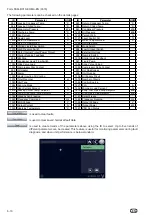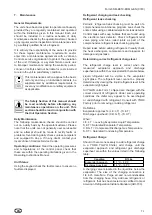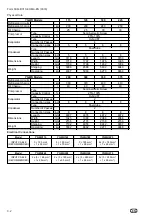
7-3
EN
Form 6S6I-B01C-EOMA-EN (0318)
Reliable water treatment companies are available in
most large cities to supply a water treating process
which will greatly reduce the corrosive and scale
forming properties of almost any type of water.
As a preventive measure against scale and corrosion
and prolong the life of evaporator and condenser tubes,
a chemical analysis of water should be made, preferably
before the system is installed. A reliable water treatment
company can be consulted to determine whether water
treatment is necessary, and if so, to finish the proper
treatment for particular water condition.
Condenser and evaporator water side tube cleaning
procedure
The standard condenser tubes used in YORK YGWH
Chiller are internally enhanced copper tubes.
If the equipment is located in an unheated
area that is susceptible to freezing, the
water must be drained from the condenser
to prevent tube failure from freezing.
Proper condenser water treatment can
eliminate or significantly reduce the formation of scale
on the waterside of the condenser tubes.
Maintain a minimum condenser water flow rate through
the tubes of at least 3.33 ft/sec. (1 meter/sec.). Through
tube water velocity should not exceed 12 ft/sec. (3.6
meter/sec.).
Condenser tubes must be maintained to provide proper
chiller operation. Condenser Approach Temperature is a
useful tool to monitor the performance of the condenser.
By recording and logging the Condenser Approach
Temperature as part of the chiller maintenance
program, this will provide a warning that the waterside
condenser tubes are fouled and require cleaning.
Condenser Approach Temperature is the difference
between the Condenser Leaving Water Temperature
and the Saturated Condensing Temperature.
If the approach increases above 3.5°C, or during
the annual condenser inspection and the tubes are
observed to be fouled, the tubes will require cleaning.
For condenser fluids other than water consult with
the local YORK Field Service Office for the correct
condenser approach temperature.
Condenser water side tube cleaning procedure
Two methods are used for waterside tube cleaning to
remove the scale; chemical and mechanical cleaning
procedures. The composition of the scale will determine
which method will be most effective to remove the scale
and dirt.
Consult with the local YORK Field Service Office for
a recommendation of the method(s) used in the local
area.
Chemical Cleaning Procedure
Chemical cleaning is an effective method to remove
scale from internally enhanced copper tubes. However,
a company knowledgeable with the chemical cleaning
procedure should be contracted or consulted. Follow
the chemical cleaning company recommendations
concerning solution cleaning strength and time duration
of the cleaning process.
Serious damage to the condenser tubes will result if
the chemical cleaning procedure is improperly applied.
Mechanical tube cleaning must always follow a
chemical cleaning procedure.
When chemical cleaning of the condenser tubes
is required, it may be necessary to calculate the
internal volume of the waterside condenser tubes. This
information is necessary to properly mix the correct
concentration of cleaning solution.
Standard materials of construction for YORK YGWH
Chiller condensers is copper tubes and mild carbon
steel water boxes.
Mechanical Cleaning Procedure
1. Drain the water from the condenser.
2. Remove the water boxes from both ends of the
condenser. Use proper lifting equipment when
removing the water boxes. Use caution not to damage
the threads on the mounting studs that are welded to
the tube sheet.
3. Select a tube cleaning brush for 3/4 inch
I.D copper condenser tubes. If tubes other
than 3/4 inch copper are used, select a tube
cleaning brush that is made for the tube size.
Generally, brushes made of hard plastic or brass
bristled wires are preferred for cleaning copper tubes.
4. Attach the tube cleaning brush to the end of a
cleaning machine or cleaning rod.
5. Flush the condenser with clean water to remove the
debris.
6. Replace the water box gasket with a new gasket and
reassemble the water boxes onto the condenser.
Summary of Contents for YGWH 115
Page 2: ......
Page 10: ...1 6 EN Form 6S6I B01C EOMA EN 0318 Page Left Intentionally Blank...
Page 24: ...4 8 EN Form 6S6I B01C EOMA EN 0318 Customer Connections...
Page 40: ...6 14 EN Form 6S6I B01C EOMA EN 0318 Page Left Intentionally Blank...
Page 58: ...10 2 EN Form 6S6I B01C EOMA EN 0318 Page Left Intentionally Blank...
















































